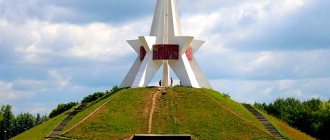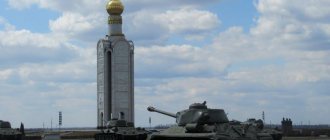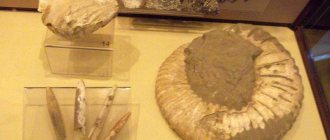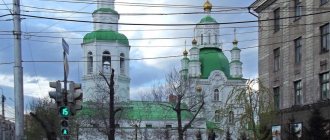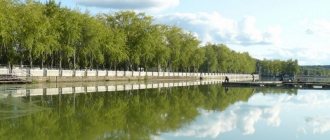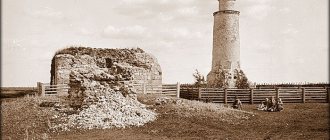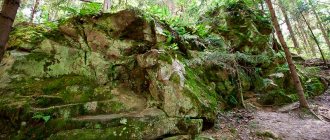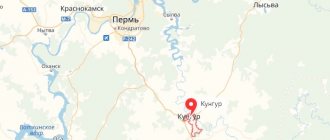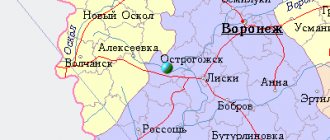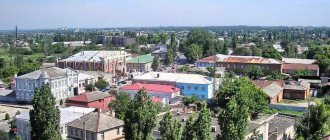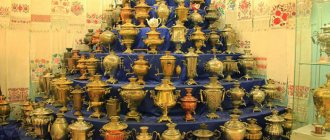History of the museum
The museum was founded in 1919. Initially, it was scientific and artistic; Pavel Ivanovich Truntaev was appointed as the first director. At that time there were two departments: natural history and art. In the first, collections of zoology, geology and botany were presented. In the second, they collected works of art from local estates - paintings, art glass, tapestries, beads and much more. Currently, the museum is a branch of the Ivanovo Regional Art Museum1.
The museum has two permanent exhibitions. The first, an art room in an ancient building on Komsomolskaya Street; the second, historical one - on Lenin Street, building 2.
Museum of JSC "Electrocontact"
Address: Kineshma, st.
Vichugskaya, 150 Phone: 8 (49331) 9-47-03
JSC "Electrokontakt" is one of the leading specialized enterprises in Russia for the production of products from metal powders and electrocarbon products. Main types of products: electric brushes, electrical contacts based on silver and tungsten, magnetic cores, products based on copper, brass, bronze, iron.
The founder of the enterprise is the talented inventor Andrei Ivanovich Buksenmeister, who in 1878 opened the first and at that time the only enterprise in Russia for the production of electric coal products in Kineshma. In 1900, the plant mastered the production of Yablochkov candles and electrodes for them, as well as electric lamps with carbon filaments and candles of the Büxenmeister system. Since 1890, the production of electric brushes began. Currently, there are only three such enterprises in the country, with ZAO Elektrokontakt being the oldest.
The museum of Electrokontakt JSC tells about the history of the enterprise. The exhibition contains photographs, archival documents relating to the activities of A.I. Buchsenmeister and the enterprise as a whole. Among the museum exhibits is an authentic portrait of the founder of the plant, a diarama of the first enterprise, booklets and catalogs with a list of products, account books, and awards. There is a stand telling about international cooperation with China.
The museum was restored for the 140th anniversary of the plant and opened on October 2, 2018.
Exposition
Among the artists whose works are presented in the museum are such outstanding painters as Savitsky, Kiselev, Vinogradov, Aivazovsky and Korovin. The sculpture is represented by the names of F. Chopin and P. Klodt von Jurgensburg, as well as many local masters. It is also worth noting the excellent collection of porcelain from the largest Russian and European manufactories: the Imperial Porcelain Factory, the M.S. Kuznetsov Partnership, the German Porcelain Factory in Thuringia, the Copenhagen, Vienna, Meissen manufactories, private factories of F. Gardner, A. Kiselev, A. Popov . There is also a large collection of antique furniture.
The historical exhibition is presented with materials on the history of the region, its nature - geology, animals, plants.
LiveInternetLiveInternet
Friday, February 17, 2012 02:53 + to quote book I admit right away that I have never been to this small historical city in the Ivanovo region on the right bank of the Volga, but I have often come across paintings on the Internet from the collections of the Kineshma Art and Historical Museum. That’s why I decided to find out more about the museum and present you the masterpieces of its collection. The museum was founded in 1919 on the initiative of the county department of public education. Now it consists of three buildings - a local history museum, an exhibition hall and an art gallery. On March 25, 1919, the Kineshma District Museum was located in the building of a former religious school on Krasnaya Street, where the museum received only a third of the ground floor. Pavel Ivanovich Truntaev (1873 – 1940), an artist by training, a former teacher of fine arts, was appointed head of the museum. Already in 1922, the museum had two departments: natural history and art. The artistic collection was represented by collections of paintings, tapestries, furniture, decorative and applied arts, nationalized from the noble estates of the county. The most significant collection was taken from the estate of Nikolai Pavlovich Ruzsky (1865-1927) “Icy Keys”. Yarovoy Portrait of N.P.Ruzsky. Ruzsky first served in the Department of Railways, then in the State Bank, he had a huge fortune, owned a sugar factory and a shipping company. After the revolution of 1917, the family left Russia and lived in Paris. However, the museum’s exhibition at that time had a very primitive appearance. In those years, a dense, several-tiered display of exhibits on the walls and an elementary layout in display cases were widespread. The building was completely unsuitable for the work of the museum, and one employee, in the person of the director, was unable to raise the work to the proper level. However, P.I. Truntaev tried with all his might to organize the work of the museum; he organized traveling exhibitions, gave lectures, conducted excursions and was busy with new premises for the museum. On September 1, 1928, the museum was transferred to the building of the Peasant House on Sovetskaya Street, but the building was not suitable for exhibition, so the museum was closed to the public, and the collection was stored in the hall of the school named after. A.N. Ostrovsky. Finally, in January 1930, the museum was moved to the building of the Church of the Ascension, since at that time the fight against religion had taken on a special scale. In the Church of the Ascension, the domes were demolished, the wall paintings were destroyed, and the bell tower and fence were destroyed. And it was this building that became the home of the Kineshma Museum for exactly 60 years. The museum was opened to the public on April 20, 1930, and from that moment on it began to be called a local history museum. From 1932 to 1934 P.I. Truntaev, for unknown reasons, was transferred to work in the archive, and upon returning to the museum he saw it in complete ruin, since during this time the Department of Public Education replaced four directors, who were sometimes semi-literate, as a result of which some of the museum’s valuables were simply stolen. P.I. Truntaev made every effort to eliminate the current situation, but realizing that without a repository it is impossible to hold exhibitions, and with a lack of personnel it is impossible to organize educational work, he submits his resignation, remaining at the museum as a research assistant. In 1938, Vladimir Perfilyevich Fomin was appointed as the new director, who went to the front on July 23, 1941. Since September 1941, the museum was closed due to martial law; since January 1942, the Kineshma Museum was headed by Elena Timofeevna Sorokina, and during the war the museum did not stop its activities. Elena Timofeevna Sorokina In 1965, the art department of the museum, in order to expand the exhibition area, was transferred to the building of the Trinity Cathedral and since 1969 it has become a branch of the Ivanovo Regional Art Museum. The merger of museums in Kineshma took place in 1998. The art gallery is now located in an architectural monument of the 19th century - a former charity home for the poor with the house Church of the Blessed Virgin Mary. The art gallery presents works by I. Aivazovsky, A. Schilder, K. Korovin, S. Vinogradov, V. Kotarbinsky, K. Savitsky, V. Golike, L. Turzhansky, K. Lebedev, S. Svyatoslavsky, V. Bychkov and others One of the halls creates the atmosphere of an estate salon from the last century. The “Art of the 20th Century” hall exhibits works by artists whose work is associated with Kineshma. The classical school is represented by paintings by L. Chernov - Plesssky, the famous battle painter P. Krivonogov, and people's artist M. Malyutin. Among the artists of the modern school we can name B. Kozlov, V. Goppe, V. Shagin, V. Shlyundin, I. Belyaev, E. Trofimov, E. Voinova, ceramists A. Severov and K. Yuryzhev. And now a small gallery from the funds of the art gallery of the Kineshma Art and Historical Museum. Vladimir Orlovsky Crimean sketch. 1880 Ivan Aivazovsky Trebizond. 1887 Wilhelm Kotarbinski (1849–1921) Adagio. Anton Ebert Portrait of a Peasant. Second half of the 19th century Konstantin Savitsky On the outskirts of the village. 1892 E.K. Vrzhec (1853–1917) Cemetery Church. Claudius Lebedev (1852–1916) Scene from boyar life. Nikolai Pymonenko (1862–1912) Flower saleswoman. Early 20th century. Nikolai Pymonenko (1862–1912) Sick. Early 20th century. Andrey Shilder Forest wilderness. 1915 Mikhail Markichev Offended. 1910s Leonid Chernov-Plessky Sennaya Square (in Kineshma). 1910 Leonid Chernov-Plessky Nizhny Ples. 1917 Vyacheslav Bychkov Bazaar. 1916 Sergei Vinogradov Sunlight through colored glass. 1916 Pyotr Krivonogov Volga. Kineshma. 1958 K. Vasiliev Tanya. 1960s Lev Uspensky Kineshma. Zarechye. 1985 Lev Uspensky Drama. 1958 Nikolay Lagoyda Autumn Reach. Materials taken from the official website of the museum. Many thanks to priest Konstantin Parkhomenko, who posted reproductions of paintings on his website “The ABC of Faith” after visiting the city of Kineshma and the art gallery.
| Categories: | Museums |
Tags:
museums
Cited 7 times Liked by: 4 users
Like share
0
Like
- 4
I liked the post - Quoted
- 0
Saved
- Add to quote book
- 0
Save to links
Liked4
0
Tickets and opening hours
A visit to the museum for an adult will cost 100 rubles, for students and pensioners 80 rubles, and for schoolchildren only 30 rubles. You can book a tour at the museum for an additional fee. Children under 7 years old can visit for free.
The museum is open from Tuesday to Sunday from 10:00 to 18:00, closed on Monday. The ticket offices close half an hour before closing.
Fire Museum
Address: Kineshma, st. Ostrovsky, 4
Telephone:
8(49331)5-55-20 The Kineshma Fire Museum is located at the base of the 13th fire and rescue unit on Ostrovsky Street. It is worth noting that local firefighters had been nurturing the idea of creating a fire museum for several years. Already in 2014, a fire pump, which was used to extinguish fires at the beginning of the 20th century, as well as a fire monitor, appeared next to the rescue unit. In 2020, the fire museum received new development. On October 8, 2020, a corresponding exhibition opened in the fire and rescue department building. The museum's exposition presents many exhibits related to the history of the fire department of the city and region. These are firefighter combat clothing, helmets, fire-fighting equipment, fire extinguishers, a fire department communications console with direct lines to services and city facilities, a radio station for communication between fire departments, dosimeters, and an exposure meter for calculating forces and resources during a fire. Here you can see breathing apparatus, starting with the closed-type oxygen-isolating apparatus KIP 7 and ending with the AN Omega open-type compressed air apparatus and much more. The stands display the history of the fire department, the leadership of the unit, photographs of employees awarded medals for courage and for emergency response.
Visiting the museum is possible for school groups upon prior request.
Kineshma Art and History Museum. Virtual tour
The Kineshma Museum turned out to be one of those customers with whom it was a pleasure to work. What is important in our work? Of course, efficiency. Having a constant flow of orders to create virtual tours, we cannot endlessly work on the same project. What we liked about Kineshma was that literally one week passed from the moment of shooting to the full execution of the contract. As a result, the museum received two virtual tours - in the historical and art departments, and we received timely payment for services and another satisfied client.
Technically, such projects can be completed in just a couple of days. One day is shooting, the second is processing, assembly and presentation of the product. It will take some more time to finalize. So in the Kineshma Museum we had to correct the names of the points, remove red fire extinguishers and fire shields from the panoramas, which spoiled the whole view, and make a couple of panoramas more contrasting.
A little extra time was needed to add photographs of some of the most valuable exhibits. These photos pop up on the screen when you click on hot spots, giving you the opportunity to look at the item in more detail.
We worked in constant contact with the responsible museum employee and quickly brought the product to the point of signing the acceptance certificate. This option looks much better than the situation when the customer, citing being busy, cannot look at the preliminary result of the work for a month and issue a list of comments. Alas, such cases also happen to us.
By that time, we are already working on completely different products and it takes time to remember the features, agreements and nuances of the abandoned work.
But the Kineshma Museum, obviously, was really interested in getting results quickly. And now two virtual tours were born, each of which allows you to look at one of the departments of the museum.
Total volume of both products: 24 full spherical panoramas with 16k resolution. Even if we didn’t take individual photos that pop up when you click on a hot spot, this resolution would be quite enough to take “a couple of steps” towards the exhibit you like when viewing panoramas and examine it in detail.
However, we couldn’t do without additional photos. The reason for this is reflections in shop windows. They make it difficult to see the exhibits located behind the glass. No matter how hard we tried, in some places we were unable to select a panorama shooting point that would eliminate all reflections. I had to resort to shading the background and additional shooting of individual parts of the exposure.
It is for this reason that we recommend performing spherical photography in the dark. If the premises have windows, then daylight from them will not be reflected in the glass of the display cases and interfere with viewing the exhibition.
We invite you to watch virtual tours of the Kineshma Art and History Museum. We especially recommend paying attention to the art department. There is an unexpectedly successful collection of genuine works of art by the greatest masters for a small town.
Historical department
Art department
